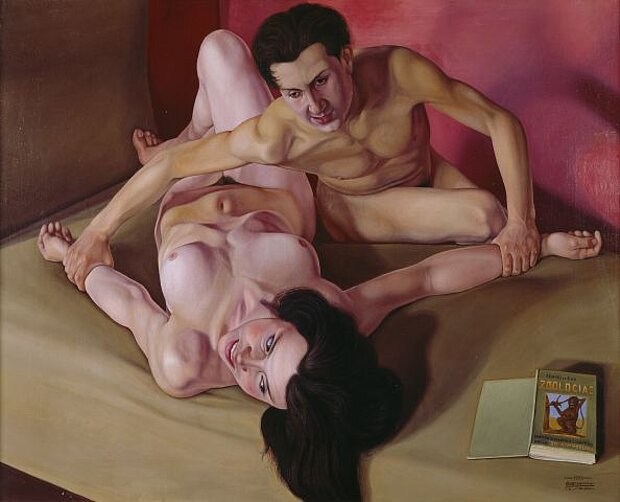
Cagnaccio di San Pietro
Zoologia
1928

© mumok
| Object description | Oil on canvas |
|---|---|
| Object category | painting |
| Material |
Support:
canvas
Object:
oil paint
|
| Technique |
Object:
oil paintings
|
| Dimensions |
Objektmaß:
height: 85 cm,
width: 106 cm
Rahmenmaß:
height: 99,5 cm,
width: 120,7 cm,
depth: 5 cm
|
| Year of acquisition | 1977 |
| Inventory number | B 302/0 |
| Creditline | mumok - Museum moderner Kunst Stiftung Ludwig Wien |
| Rights reference | Gemeinfrei | public domain |
| Further information about the person | Cagnaccio di San Pietro [GND] |
| Literature |
Realismo Magico. L'incanto nella pittura italiana degli anni Venti e Trenta UNHEIMLICH.Italienische Malerei der 1920er Jahre Realismi Magici. Pyke Koch e Cagnaccio di San Pietro |
The 1920s style for which the Italian painter Cagnaccio di San Pietro became renowned is known as magic realism. This is the Italian version of new objectivity, with cool colors, hard lines and edges, and precise outlines. Cagnaccio‘s work includes still lifes, portraits, and a few nudes—one of which you can see here. The work was painted in 1928, a key year in the artist’s creative work. His contribution to the 16th Biennale in Venice caused a scandal. The work he submitted, “After the Orgy,” was also a nude—as the title indicates—but it contained details that denigrated fascist symbols. Margherita Sarfatti, Benito Mussolini’s commissioner for culture, was a member of the Biennale jury. The reaction to this work was so strong that Cagnaccio admitted himself to a Venetian hospital under false pretenses, so as to escape persecution by the fascists. “Zoologia” was painted in the same year. It is a very special treatment of relations between the sexes. It shows a woman and a man naked on a bed, but their lovemaking is not a tender embrace. It is almost violent. The man is bending over the woman, holding her arms down, but otherwise the two are not touching. Only the shadow of the man’s bent body falls on her belly. Everything is calm, no one is shouting or screaming, no one seems to be angry, but nonetheless this looks like a fight. The man’s gestures are aggressive, and the woman has turned her head away and is looking at a point outside the canvas. Cagnaccio is practicing the representation of daring abbreviation, as the arms and bodies are like tense triangles—a principle of composition that can also be seen in the proportions of the bed and the walls. The figure of the man is a self-portrait, a form of identification here that is unique to Cagnaccio’s work. What exactly does the painter see himself as here? The title of this painting is “Zoologia,” which can also be seen on the cover of the book on the bed. The authors are Adam and Eve. Beneath a picture of a monkey, we can read: Edition revised and corrected by modern society. This is not exactly a clear explanation of what the painter is attempting in this strange scene. It is the animal inside us that drives our desire and our sexuality in modern society? Is this about the question as to how far we have developed away from apes and how much ape is still within us?
© mumok – museum moderner kunst stiftung ludwig wien